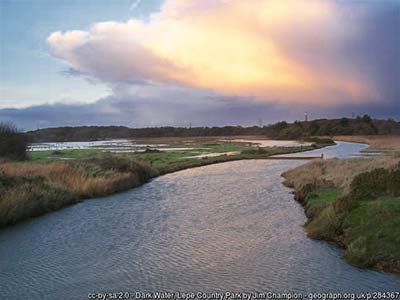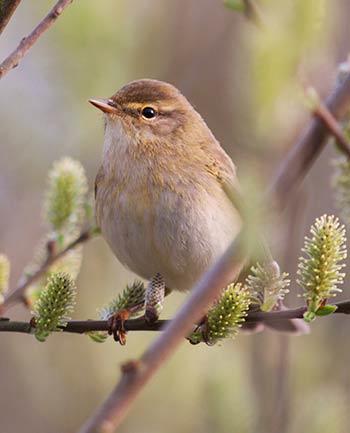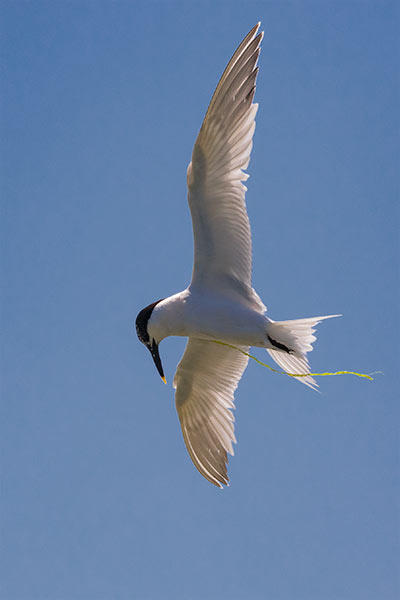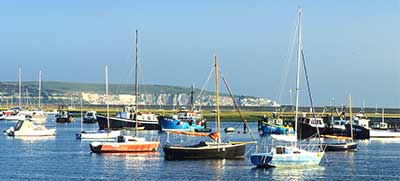Lepe wildlife
Lepe Country Park and the adjacent countryside contain an impressive variety of wildlife habitats that provide homes for a wide range of fascinating species. There's the open water of the Solent and the adjacent seashore with its sand, shingle and mudflats; woodland and scattered trees; hedgerows; farmland; ponds; streams; scrub and short-cut lawns.
Here, then, is a brief introduction to many of the more significant aspects of the wildlife that can be found at Lepe:
(Skip down the page to find out more about Lepe Country Park, Lepe's history and heritage, and Lepe walks).
(1) A short introduction

Be sure to visit the Lepe Local Nature Reserve, a protected area for wildlife with a bird-watching hide, pond and boardwalk. And then there are specially maintained wild flower meadows, a Sensory Cottage Garden and wild flowers within the woodlands and alongside the traditionally managed hedgerows that all attract bees, butterflies and other insects.
On and around the seashore, look out for salt tolerant wild flower species such as the yellow-horned poppy, sea pink, or thrift as it is often known, sea campion, sea purslane and sea beet.
Autumnal fungi can be found growing on dead and decaying timber within the woodlands, hawthorn and other berries in autumn light up the hedgerows and provide food for birds and small mammals, whilst spring and summer dragonflies and damselflies skim over the surface of the pond.
Roe deer might be seen in the quieter areas; foxes can be expected to be on the prowl once most of the visitors have departed, or maybe earlier in winter when foxy food is in short supply; occasional badgers might leave the safety of their woodland homes and wander the field edges and hedgerows; whilst a host of small mammals - mice, voles and shrews - will invariably be present. And then less to be expected, but occasionally observed offshore, are common seals and grey seals.
(2) Widely varied birdlife
Scattered pines and other conifers attract roaming bands of small birds and there is always a chance of seeing a tiny goldcrest amongst them and the equally small but comparatively rare firecrest. If good views are obtained, look out for the crown stripe - it is golden yellow mixed with orange in both species.
Warblers, too, are well-represented in spring, summer and early autumn. Chiffchaffs are often the first spring arrivals, although small numbers do now over-winter in Hampshire. Listen for their distinctive, repeated chiff-chaff, chiff-chaff, chiff-chaff song.

Others present include willow warblers, garden warblers and blackcaps, but the undoubted star of the show, the Cetti's warbler, is more often heard rather than seen.
A nondescript-looking little bird that over-winters in Hampshire and some other southern counties, the Cetti's warbler has plumage that lacks colour but that is more than made up for by its song, a loud, explosive medley of what has been described as 'a sudden loud outburst of metallic, clanging notes', usually from deep within the cover of reeds or scrub.
Lepe Country Park's coastline and the Dark Water estuary are good spots to see incoming migrant birds in spring and outgoing birds in autumn. Look out, in particular, for swallows, house martins, wheatears and whinchats; listen for the first cuckoos of spring and out in the Solent there might also be skuas or other relatively exotic seabirds passing by.
Whimbrels, quite large wading birds with long, de-curved, curlew-like bills, stay to rest and feed, particularly in late summer and autumn.
But ospreys, large fish-eating birds of prey are many peoples' favourite sighting as these majestic creatures move through in spring en-route to breeding grounds farther north, and in late summer and autumn to African wintering grounds.

Out over the waters of the Solent, terns - often quite rightly know as sea swallows - fly gracefully by, stopping intermittently to hover before plunging down to catch an unfortunate fish or other delicacy.
Sandwich terns, the largest of the group, with a long black bill with a yellow tip, are usually the earliest arrivals, appearing from March onwards, often after wintering in Africa.
Little terns and common terns appear in April, whilst passage black terns, arctic terns and roseate terns may also be seen from April. All fly south to spend our winter in warmer climes.
The relatively mild south coast climate also attracts many other birds that flee colder breeding grounds to the north and east, and find that the Lepe mudflats and shoreline offer welcome respite during autumn and winter.
Prominent amongst these are likely to be flocks of dark-bellied brent geese and waders such as curlews, oystercatchers, ringed plovers, grey plovers, turnstones, redshanks and dunlins. Small numbers of waders might also be seen throughout the year, but the largest numbers occur in autumn and winter.
Find out more about Lepe and the Country Park
References:
Hampshire Ornithological Society Bird Reports
The Flora of Hampshire: Anne Brewis, Paul Bowman and Francis Rose
The Butterflies of Hampshire: Mathew Oates, John Taverner, David Green et al
The Dragonflies of Hampshire: John Taverner, Steve Cham, Alan Hold et al
A Guide to the Dragonflies of Britain: Dan Powell
Butterflies of the British Isles: JA Thomas
Quick links
More links
Search this site

